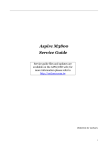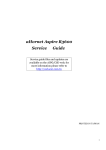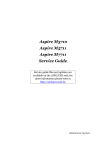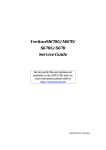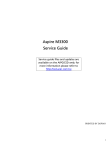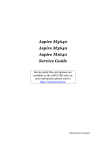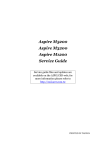Download Acer Aspire M7720 Technical information
Transcript
Aspire ASM7720 Service Guide Service guide files and updates are available on the AIPG/CSD web; for more information please refer to http://csd.acer.com.tw PRINTED IN TAIWAN 1 Revision History Please refer to the table below for the updates made on aBulldog ASM7720 Service Guide. Date Chapter Updates 2 Copyright Copyright © 2007 by Acer Incorporated. All rights reserved. No part of this publication may be reproduced, transmitted, transcribed, stored in a retrieval system, or translated into any language or computer language, in any form or by any means, electronic, mechanical, magnetic, optical, chemical, manual or otherwise, without the prior written permission of Acer Incorporated Disclaimer The information in this guide is subject to change without notice. Acer Incorporated makes no representations or warranties, either expressed or implied, with respect to the contents hereof and specifically disclaims any warranties of merchantability or fitness for any particular purpose. Any Acer Incorporated software described in this manual is sold or licensed "as is". Should the programs prove defective following their purchase, the buyer (and not Acer Incorporated, its distributor, or its dealer) assumes the entire cost of all necessary servicing, repair, and any incidental or consequential damages resulting from any defect in the software. Acer is a registered trademark of Acer Corporation. Intel is a registered trademark of Intel Corporation. Pentium 4 and Celeron are trademarks of Intel Corporation. Other brand and product names are trademarks and/or registered trademarks of their respective holders. I Conventions The following conventions are used in this manual: SCREEN Denotes actual messages that appear on screen. MESSAGES NOTE Gives bits and pieces of additional information related to the current topic. WARNING Alerts you to any damage that might result from doing or not doing specific actions. CAUTION Gives precautionary measures to avoid possible hardware or software problems. IMPORTANT Remind you to do specific actions relevant to the accomplishment of procedures. IV Preface Before using this information and the product it supports, please read the following general information. 1. This Service Guide provides you with all technical information relating to the BASIC CONFIGURATION decided for Acer's "global" product offering. To better fit local market requirements and enhance product competitiveness, your regional office MAY have decided to extend the functionality of a machine (e.g. add-on card, modem, or extra memory capability). These LOCALIZED FEATURES will NOT be covered in this generic service guide. In such cases, please contact your regional offices or the responsible personnel/channel to provide you with further technical details. 2. Please note WHEN ORDERING FRU PARTS, that you should check the most up-to-date information available on your regional web or channel. If, for whatever reason, a part number change is made, it will not be noted in the printed Service Guide. For ACER-AUTHORIZED SERVICE PROVIDERS, your Acer office may have a DIFFERENT part number code to those given in the FRU list of this printed Service Guide. You MUST use the list provided by your regional Acer office to order FRU parts for repair and service of customer machines. V Chapter 1 System Specifications 1 Features……………………………………………………………………………………………... 1 Block Diagram…………………………………………………………..………………...………..6 Aspire ASM7720 Front Panel………………………………………..…….………..7 Aspire ASM7720 Rear Panel…………………..…………………………….……………………8 Hardware Specifications and Configurations………………….…….……..9 Power Management Function (ACPI support function)…………………………..…...16 Chapter 2 System Utilities 17 Entering Setup…………………………………………………………………………..18 Product Information………………………………………………………..20 Standard CMOS Features……………………………….……………………………………21 Advanced BIOS Features………………………………………..……………………23 Integrated Peripherals…………………………...…………………………………………..25 Power Management…………………………………………………………27 PC Health Status……………………………………………………………...28 Frequency/Voltage Control……………..………………………….…….29 BIOS Security Features……………………………………………………………...30 Load Default Settings………………………………………………..……. 31 Save & Exit Setup………………………………………………….…………32 Exit Without Saving………………………………………………….……..33 Chapter 3 Machine Disassembly and Replacement 34 General Information………………………………………………………. 34 Disassembly Procedure……………………………………………………36 Aspire ASM7720 Disassembly Procedure…………….…..……37 Chapter 4 Troubleshooting 51 Chapter 5 Jumper and Connector Information 52 Jumper Setting…………………………………………………..………………..52 Chapter 6 FRU (Field Replaceable Unit) List 57 Exploded Diagram………………………………………………………….58 Chapter 1 System Specifications Features Operating System Microsoft Windows Vista Premium 64-bit Processor Socket Type: Intel® Socket T LGA 1366 pin Processor Type: Intel Bloomfield i7 CPUs FSB 1600 MHz CPUs Chipset Intel X58 + ICH10R PCB Form Factor: Micro ATX Dimension/Layer: 244mm x244mm Memory Memory Type: DDR3 1066 Support single channel 64 bit mode with maximum memory size up to 12GB Support un-buffered DIMM (ICH10R) DIMM Slot: 6 Memory Max: 1GB to 12GB DDR3 memory technologies Capacity: Up to 2GB per DIMM with maximum memory size up to 12GB PCI PCI Express Slot Type: x16 PCI Express Slot Type: x4 PCI Express x16 Slot Quantity: 2 PCI Express x4 Slot Quantity: 1 PCI Express Slot Type: x1 1 PCI Express x1 Slot Quantity: 1 SATA Slot Type: SATA slot Slot Quantity: 6 Storage Type support: HDD/CD-ROM/CD-RW/DVD-ROM/DVD-RW/DVD+RW/DVD Dual/DVD SuperMultiPlus/Blu-Ray ODD Audio Audio Type: HD audio codec Audio Channel: 7.1 channel Audio Controller /Codec: ALC888S-VE 7.1 Connectors support: Rear 6 jack follow HD audio definition, Audio jacks color coding: should meet Microsoft Windows Logo Program Device Requirements: Audio-0002 1 front panel audio header (2*5) S/N ratio: 90 dB at rear output jack LAN MAC Controller: ICH10R Should be worked under 10M/100M/1000Mbs environment PHY: Intel 82567LF Boazman Gbe Ethernet LAN PHY. USB Controller Type: ICH10R Ports Quantity: 12 6 back panel ports On-board: 3 2*5 headers ( 6 ports) 4 ports for front daughter board 2 ports for internal card reader 2 Data transfer rate support: Connector Pin: standard Intel FPIO pin definition USB 2.0/1.1 Design Criteria: Should meet Acer USB drop criteria 1394 Controller: VIA 6315N 1394a controller Connector Quantity: 2 1 rear 6pin IEEE1394 port 1 2x5pin onboard jumper BIOS BIOS Type: Phoenix Award or AMI Kernel with Acer skin Size: 32Mb Note: Boot ROM should be included (PXE function should be built in with default and RPL function is optional by service BIOS) BIOS shall auto detect FDD to avoid checksum error when boot I/O Connector Controller: Super I/O ITE8720 (F stepping or after; must full support Intel platform) Rear I/O Connector 1 PS/2 Keyboard port, 1 PS/2 Mouse port, 2 e SATA ports 1 RJ45 LAN port, 1 IEEE 1394 port 6 USB ports 7.1 channel phone jack (6 audio jacks) 3 On-board connectors 1 CPU socket 6 DDR-3 memory sockets 2 PCI Express x16 slot 1 PCI Express x 4 slots 1 PCI Express x 1 slots 6 SATA connectors(Need to confirm no interfere with gfx card) 3 2*5 pin Intel FPIO specification USB pin connectors (follow Intel FPIO standard Specification) 1 2*5 pin IEEE1394 jumper 1 2*5 pin Intel FPIO spec. Microphone In/ Headphone Out pin connectors 1 serial port 2*5 pin connector 1 4 pin CPU/SYS Fan connector 5 3 pin System FAN connector with linear circuit 1 24pin + 8pin ATX interface PS3/PS2 SPS connector 1 2*7 pin front panel IO header 1 Jumper for clear CMOS 1 on board buzzer Color management for on board connecter (pls provide proposal) Power Supply Power Supply Mounting Features Chassis accepts ATX-style power supply Chasses accepts PS2, PS3 style power supply Features for internal mounting tab Location of 4 external mounting holes Power Supply Electrical Design Feature 400W ~1000W in stable mode (Acer Assign System Power Unit) Voltage design should be covered +5V, +3.3V, +12V, +5VSB, -12V (attention to 4 12V output capability) Demand for both PFC/Non-PFC solutions (two different quotations are needed) Minimum 6 Serial ATA power connector solution should be included (by default) Minimum 3 6-pin graphic card connector included Minimum 2 big 4-pin power connector included Full Range PSU PS2 style 5 Block Diagram 6 Aspire ASM7720 Front Panel The computer’s front panel consists of the following: Label Description 1 Media Control Center 2 Optical drive 3 Speaker /Microphone jack 4 Gateway Logo 5 Card reader 6 Power button 7 Aspire M5700 Rear Panel 1 8 2 3 9 4 5 10 6 4 7 11 12 13 Label Label Description Description 1 Voltage selector switch 8 Fan aperture 2 Power card socket 9 PS/2 mouse connecter 3 PS/2 keyboard connecter 10 System FAN 4 Serial port 11 1394 connector 5 ESATA port 12 LAN connector 6 USB 2.0 connector 13 Lock Handle 7 Audio connector 8 Hardware Specifications and Configurations Processor Item Specification Type Intel Bloomfield i7 CPUs Socket LGA 1366 pin FSB 1600 MHz Minimum operating speed 0 MHz (If Stop CPU Clock in Sleep State in BIOS Setup is set to Enabled.) BIOS Item Specification BIOS code programmer Phoenix Award or AMI Kernel with Acer skin BIOS version R01-A1 BIOS ROM type SPI Flash BIOS ROM size 32Mb Support protocol SMBIOS(DMI)2.4/DMI2.0 Device Boot Support - Support to LS-120 drive YES Support to BIOS boot block feature YES 1st priority: SATA HDD 2nd priority: CD-ROM 3rd priority: FDD 4th priority: LAN 5th priority: USB device 9 BIOS Hotkey List Hotkey Del Function Enter BIOS Setup Utility Description Press while the system is booting to enter BIOS Setup Utility. Main Board Major Chips Item Specification North Bridge Intel X58 South Bridge ICH 10R APG controller Intel X58 Super I/O controller ITE 8720 Audio controller Realtek HD audio codec ALC888S-VE codec 7.1 (co-lay with ALC888) LAN controller Intel 82567LF Boazman Gbe Ethernet LAN PHY HDD controller ICH 10R Keyboard controller ITE 8720 10 Memory Combinations Slot Memory Total Memory Slot 1 1GB, 2GB 1GB ~2GB Slot 2 1GB, 2GB 1GB ~2GB Slot 3 1GB, 2GB 1GB ~2GB Slot 4 1GB, 2GB 1GB ~2GB Slot 5 1GB, 2GB 1GB ~2GB Slot 6 1GB, 2GB 1GB ~2GB Maximum System Memory Supported 1GB ~12GB System Memory Item Specification Memory slot number 6 slot Support Memory size per socket 1GB/2GB Support memory type DDR3 Support memory interface DDR3 1066MHz Support memory voltage 1.5V Support memory module package 240-pin DDR3 Support to parity check feature Yes Support to error correction code (ECC) feature No Memory module combinations You can install memory modules in any combination as long as they match the above specifications. 11 Audio Interface Item Specification Audio controller Intel ICH 10R Audio controller type ALC888S-VE Audio channel codec 7.1 Audio function control Enable/disable by BIOS Setup Mono or stereo Stereo Compatibility Sound Blaster Pro/16 compatible Mixed digital and analog high performance chip Enhanced stereo full duplex operation High performance audio accelerator and AC’97 support Full native DOS games compatibility Virtual FM enhances audio experience through real-time FM-to-Wavetable conversionMPU-401 (UART mode) interface for Wavetable synthesizers and MIDI devices Integrated dual game port Meets AC’97and WHQL specifications Music synthesizer Yes, internal FM synthesizer Sampling rate 48 KHz (max.) MPU-401 UART support Yes Microphone jack Supported Headphone jack Supported 12 SATA Interface Item Specification SATA controller Intel ICH 10R SATA controller resident bus PCI bus Number of SATA channel SATA X 6 Support bootable CD-ROM YES USB Port Item Specification Universal HCI USB 2.0/1.1 USB Class Support legacy keyboard for legacy mode USB Connectors Quantity 6 back panel ports 4 ports for front daughter board 2 ports for 3.5’’ card reader module 13 Environmental Requirements Item Specification Temperature Operating +5°C ~ +35°C Non-operating -20 ~ +60°C (Storage package) Humidity Operating 15% to 80% RH Non-operating 10% to 90% RH Vibration Operating (unpacked) 5 ~ 500 Hz: 2.20g RMS random, 10 minutes per axis in all 3 axes 5 ~500 Hz: 1.09g RMS random, 1 hour per axis in all 3 axes 14 Power Management Devices S1 S3 S4 S5 Power Button V V V V USB V V N/A N/A PME Disabled Disabled Disabled Disabled RCT Disabled Disabled Disabled Disabled WOR Disabled Disabled Disabled Disabled Keyboard/Mouse Devices wake up from S3 should be less than Devices wake up from S5 should be less than 10 seconds 15 16 Chapter 2 System Utilities The manufacturer or the dealer already configures most systems. There is no need to run Setup when starting the computer unless you get a Run Setup message. The Setup program loads configuration values into the battery-backed nonvolatile memory called CMOS RAM. This memory area is not part of the system RAM. NOTE: If you repeatedly receive Run Setup messages, the battery may be bad/flat. In this case, the system cannot retain configuration values in CMOS. Before you run Setup, make sure that you have saved all open files. The system reboots immediately after you exit Setup. 17 Entering Setup Power on the computer and the system will start POST (Power On Self Test) process. When the message of “Press DEL to enter SETUP” appears on the screen, press the key of [Delete] to enter the setup menu. NOTE: If the message disappears before you respond and you still wish to enter Setup, restart the system by turning it OFF and On. You may also restart the system by simultaneously pressing [Ctrl+ Alt+ Delete]. The Setup Utility main menu then appears: CMOS Setup Utiliyt – Copyright (c) 1985-2008,American Megatrends, Inc. Product Information PC Health Status Standard CMOS Features Frequency/VoltageControl Advance BIOS Features CMOS BIOS Security Features Advanced Chipset Features Load Default Settings Integrated Peripherals Save & Exit Setup Power Management Setup Exit Without Saving KLIJ: Move Enter: Select F1: General Help +/-/: Value F10: Save ESC: Exit F9: Optimized Defaults 18 The items in the main menu are explained below: Parameter Description Production Information This page shows the relevant information of the main board Standard CMOS Features This setup page includes all the items in standard compatible BIOS Advance BIOS Features This setup page includes all the items of Award special enhanced features Advance Chipset Features This setup page includes all advanced chipset features Integrated Peripherals This setup page includes all onboard peripherals Power Management Setup This setup page includes all the items of Green function features PC Health Status This setup page is the System auto detect Temperature, voltage, and fan speed Frequency/Voltage Control This setup page is the System Frequency/Voltage setup BIOS Security Features Change, set or disable password. It allows you to limit access to the System Load Optimized Defaults Load Optimized Settings Default Settings indicates the value of the system parameters which the system would be in best performance configuration Save & Exit Setup Save CMOS value settings to CMOS and exit setup Exit Without Saving Abandon all CMOS value changes and exit setup 19 Product Information The screen below appears if you select Product Information from the main menu: The Product Information menu contains general data about the system, such as the product name, serial number, BIOS version, etc. This information is necessary for troubleshooting (maybe required when asking for technical support). CMOS Setup Utiliyt – Copyright (c) 1985-2008,American Megatrends, Inc. Product Information Processor Type Intel(R) Core(TM)2 i7 CPU 920 Processor Speed System Memory System Manufacture Product Name System Serial Number System BIOS Version BIOS Release Date Asset Tag Number : ﹫2.67GHz : 2.66GHz : 4047MB : Acer : Asprie M7720 : : R01-A1 : 10/28/2008 Item Help : KLIJ: Move Enter: Select F1: General Help +/-/: Value F10: Save ESC: Exit F9: Optimized Defaults The following table describes the parameters found in this menu: Parameter Description Processor Type This item lists the product processor model Processor Speed This item lists the processor frequency for the system System Memory Total memory size for the system Product Name This item lists the product name Product Name This item lists the system BIOS version System Serial Number This item lists the system serial number System BIOS Version This item lists the system BIOS version BIOS Release Date This item lists the BIOS release date 20 Standard CMOS Setup Select standard CMOS features from the main menu to configure some basic parameters in your system the following screen shows the standard CMOS features menu: CMOS Setup Utiliyt – Copyright (c) 1985-2005,American Megatrends, Inc. Standard CMOS Features System Time System Date Item Help [11:54:33] [Wed 11/26/2008] 8AHCI Port0 [Not Detected] Use [ENTER], [TAB] or 8AHCI Port1 [Not Detected] [SHIFT-TAB] to select 8AHCI Port2 [Not Detected] A field . 8AHCI Port3 [ATAPI CDROM] 8AHCI Port4 [Not Detected] Use [+] or [-] to configure 8AHCI Port5 [Hard Disk] system Time. Halt on Setting [All, But Keyboard] KLIJ: Move ENTER: Select Item F1: General Help +/-/: Value F10: Save ESC: Exit F9: Optimized Defaults BIOS Security Features 21 The following table describes the parameters found in this menu. Parameter Description Options System Date To set the date following Week: From [Sun.] to [Sat.]. determined the by BIOS and is display only weekday-month-date-year Day: from [1] to [31] (or the maximum format allowed in the month. Year: from 1999 to 2099 System Time To set the time following the hour-minute-second format The items format is [hour] [minute][second]. The time is calculated base on the 24-hour timer clock. Halt On This item enables use to select the situation if the BIOS stops the POST process and the notification All Errors No Errors All, But Keyboard All, But Diskette All, But Disk/Key 22 Advanced Setup The following screen shows the Advanced Setup: CMOS Setup Utiliyt – Copyright (c) 1985-2008,American Megatrends, Inc. Advanced BIOS Features Reset Configuration Data Quick Boot Quiet Boot 1 st Boot Device 2 nd Boot Device Hard Disk Drives CD/DVD Devices [NO] Enabled Enabled [HDD:P0-WDC WD10EAV] [CD/DVD:P1-HL-DT-ST] [Press Enter] [Press Enter] Boot up Num-Lock On USB Beep Message Disabled KLIJ: Move Enter: Select F1: General Help +/-/: Value Item Help Clear NURAM during System Boot. F10: Save ESC: Exit F9: Optimized Defaults The following table describes the parameters found in this menu. Parameter Description Options Quick Boot Allows BIOS to skip certain tests while [Enabled], booting. This will decrease the time needed [Disabled] to boot the system 1 st Boot Device The item allows you to see the sequence of boot device where BIOS attempts to load the disk operation system. 2 nd Boot Device Hard Disk Drives CD/DVD Devices Specifies the boot device. Priority sequence from available Hard Drives Boot up Num-Lock On Select Power-on state for Numlock On,Off USB Beep Message Enables the beep during USB device enumeration [Enabled], [Disabled] 23 Advanced Chipset Setup CMOS Setup Utiliyt – Copyright (c) 1985-2008,American Megatrends, Inc Advanced Chipset Features Intel EIST Intel XD Bit Intel VT Intel VT-d Enabled Enabled Enabled Enabled KLIJ: Move Enter: Select Item Help Disable: Disable GV3 Enable: Enable GV3 +/-/: Value F1: General Help F10: Save ESC: Exit F9: Load Default Settings The following table describes the parameters found in this menu. Parameter Description Options Intel EIST For Intel platform Disabled/Enabled Intel XD Bit For Intel platform Disabled/Enabled Intel VT For Intel platform Disabled/Enabled Intel VT-d For Intel platform Disabled/Enabled 24 Integrated Peripherals CMOS Setup Utility – Copyright (c) 1985-2008, American Megatrends, Inc. Integrated Peripherals Onboard SATA Mode Onboard ESATA Controller Onboard USB Controller Legacy USB Support Onboard LAN Controller Onboard LAN Option ROM Onboard Audio Controller Onboard 1394 Controller Serial Port1 Address KLIJ: Move [AHCI] [AHCI Mode] [Enabled] [Enabled] [Enabled] [Disabled] [Enabled] [Enabled] [3F8/IRQ4] Enter: Select F1: General Help Item Help Options IDE RAID AHCI +/-/: Value F10: Save ESC: Exit F9: Optimized Defaults 25 The following table describes the parameters found in this menu. Parameter Description Options Onboard SATA Mode This item is only available when onboard SATA controller is AHCI AHCI Disabled / AHCI Onboard ESATA Mode This item is only available when onboard ESATA controller is AHCI Mode. Disabled/AHCI Mode Onboard USB Controller Always enabled USB keyboard during POST no matter what option is set Disabled/Enabled Legacy USB Support This item is only available when on board USB controller is enabled Disabled/Enabled Onboard Audio Controller Always enabled Audio POST no matter what option is set Disabled/Enabled Onboard LAN Controller Always enabled Audio POST no matter what option is set Disabled/Enabled Onboard LAN Option ROM This item is only available when onboard LAN controller is enabled Disabled/Enabled Serial Port1 Address Allows BIOS to select serial port1 base addresses Disabled / 3F8/IRQ4 / 2F8/IRQ3 / 3E8/IRQ4 / 2E8/IRQ3 26 Power Management The Power Management menu lets you configure your system to most effectively save energy while operating in a manner consistent with your own style of computer use. The following screen shows the Power Management parameters and their default settings: CMOS Setup Utiliyt – Copyright (c) 1985-2008,American Megatrends, Inc Power Management Setup ACPI Aware O/S ACPI Suspend Mode Power On by RTC Alarm Power On by PCIE Devices Power On by Modem Ring Power On By Onboard Lan Wake Up by PS/2 KB/Mouse Wake Up by USB KB//Mouse Restore On AC Power Loss [Yes] [S3 (STR)] [Disabled] [Disabled] [Disabled] [Disabled] [Enabled] [Enabled] [Last State] Item Help Yes/ No ACPI support for Operating System. Yes: If OS supports ACPI. No: If OS does not support ACPI. KLIJ: Move Enter: Select F1: General Help +/-/: Value F10: Save ESC: Exit F9: Optimized Defaults The following table describes the parameters found in this menu. Parameter ACPI Aware O/S ACPI Suspend Mode Description Control wake up event for S1/S3/S4/S5 Options No/Yes S1(POS)/S3 (STR) Power On by RTC Alarm Disabled/Enabled Power On by PCIE Devices Disabled/Enabled Power On by Onboard Lan Power On by Modem Ring Wake Up by PS/2 KB/Mouse Wake Up by USB KB//Mouse Disabled/Enabled Control wake up event for S1/S3 Disabled/Enabled Disabled/Enabled 27 PC Health Status CMOS Setup Utiliyt – Copyright (c) 1985-2008,American Megatrends, Inc. PC Health Status CPU Temperature (PECI Mode) System Temperature CPU Fan Speed System Fan Speed CPU Core +1.1V +3.30V +5.00V +12.0V 5VSB : : : : : : : : : : 35℃/95℉ 46℃/114℉ 1383 RPM 1046 RPM 1.120V 1.152V 3.277V 4.924V 11.9604V 5.053V VBAT : 3.230V Smart Fan Item Help Fan configuration mode setting [Enabled] KLIJ: Move Enter: Select F1: General Help +/-/: Value F10: Save ESC: Exit F9: Optimized Defaults The following table describes the parameters found in this menu: Parameter Description CPU/System Temperature Detect CPU Temperature automatically CPU/SYSTEM FAN Speed (RPM) Detect CPU/SYSTEM Fan Speed Status automatically CPU Smart FAN Control The item displays the system Smart Fan Function status. It is always enabled by system. Options 28 Frequency/Voltage Control CMOS Setup Utiliyt – Copyright (c) 1985-2008,American Megatrends, Inc Frequency/Voltage Control Spread Spectrum Enabled Item Help Spread spectrum modulation KLIJ: Move Enter: Select F1: General Help +/-/: Value F10: Save ESC: Exit F9: Optimized Defaults The following table describes the parameters found in this menu: Parameter Spread Spectrum Description Always auto detect Spread Spectrum Options Disabled/Enabled 29 BIOS Security Features CMOS Setup Utiliyt – Copyright (c) 1985-2008,American Megatrends, Inc. BIOS Security Features Supervisor Password User Password Change Supervisor Password : Not installed : Not Installed [Press Enter] KLIJ: Move Enter: Select F1: General Help Item Help Install or Change the Password +/-/: Value F10: Save ESC: Exit F9: Optimized Defaults The following table describes the parameters found in this menu: Parameter Change Supervisor Password Description This item is only available when supervisor password is installed, If clear supervisor password, user password should also be cleared. All setup items will be view-only except user password item when login with user password Options Press Enter 30 Load Default Settings This option opens a dialog box that lets you install defaults for all appropriate items in the Setup Utility. CMOS Setup Utiliyt – Copyright (c) 1985-2008,American Megatrends, Inc. Product Information PC Health Status Standard CMOS Features Frequency/Voltage Control Advance BIOS Features CMOS Load Default Settings? Advanced Chipset Features BIOS Integrated Peripherals [OK] Power Management Setup KLIJ: Move Enter: Select F1: General Help BIOS Security Features Loab Loab Default DefaultSettings Settings Save & Exit Setup [Cancal] Exit Without Saving +/-/: Value F10: Save ESC: Exit F9: Optimized Defaults The following table describes the parameters found in this menu: Parameter Description Load Default Settings Select the field loads the factory defaults for BIOS and Chipset Features, which the system automatically detects. This option opens a dialog box that lets you install optimized defaults for all appropriate items in the Setup Utility. Options 31 Save & Exit Setup Highlight this item and press <Enter> to save the changes that you have made in the Setup Utility and exit the Setup Utility. The following table describes the parameters found in this menu: Parameter Description Options Save & Exit Setup Press <Enter> to save the changes that have made in the Setup Utility and exit the Setup Utility. Press<Y> to save and Exit or <N> to return to the main menu. 32 Exit Without Saving Highlight this item and press <Enter> to discard any changes that you have made in the Setup Utility and exit the Setup Utility. Parameter Description Exit Without Saving Press<Enter> to discard any changes and exit the Setup Utility Options 33 Chapter 3 Machine Disassembly and Replacement To disassemble the computer, you need the following tools: Wrist grounding strap and conductive mat for preventing electrostatic discharge. Wire cutter. Phillips screwdriver (may require different size). NOTE: The screws for the different components vary in size. During the disassembly process, group the screws with the corresponding components to avoid mismatches when putting back the components. 34 General Information Before You Begin Before proceeding with the disassembly procedure, make sure that you do the following: 1. Turn off the power to the system and all peripherals. 2. Unplug the AC adapter and all power and signal cables from the system 35 Disassembly Procedure This section tells you how to disassemble the system when you need to perform system service. Please also refer to the disassembly video, if available. CAUTION: Before you proceed, make sure you have turned off the system and all peripherals connected to it. 36 Bulldog ASM7720 Standard Disassembly Process Bezel Process: 1. According to the requirement, paste ATI, OS, CPU, HDMI and marketing label by SKU. Remove side cover Process: 1. Put the Computer on the worktable lightly. 2. Release left/right side cover with 4 screws then remove left/right side cover. 37 Screw location Screw location Remove CPU fan pipe Process: 1. Release the CPU fan pipe. 2 3 1 4 38 Remove Cards Process: 1. Release the slot cover tooless 2. Remove VGA ﹑TV﹑Modem Card,the following list is for your reference about the mutual location relation (Optional by SKU). 39 Remove HDD Data Cables Process: 1. Remove master HDD data cable from M/B SATA1/SATA3(Optional by SKU). 2. Remove slave ODD data cable from M/B SATA2/SATA4(Optional by SKU) 40 Remove slave HDD cable Remove master HDD cable Remove ODD DATA cable Process: 1. Remove master ODD data/power cable from Master ODD. 41 Remove HDD power cable Process: 1. Remove master HDD data cable from master HDD. 2. Remove slave HDD data cable from slave HDD. Remove Cables Process: 1. 2. 3. 4. 5. Remove Power SW cable cable from M/B. Remove FI/O USB cable from M/B. Remove MCR USB cable from M/B. Remove Card reader cable from M/B. Remove audio cable from the “AUDIO” port on M/B. 42 Remove HDD Process: 1. Remove the screws and take out HDD bracket . 2. Remove two sides with 2 screws for each and then remove the master HDD and Slave HDD. 3. Remove Slave HDD from the second HDD location. (Optional by SKU) 43 Master HDD location 2 Slave HDD location 4 1 3 Remove ODD Process: 1. Remove bezel of chassis. 2. Remove Master ODD from the location. 3. Remove slave ODD from the location. (Optional by SKU) 44 Remove Cables Process: 1. Remove M/B power cable from M/B “ATX1”. 2. Remove 12 V power cable from M/B” JPW1” 3. Remove System Fan cable from M/B”SYS-F2”. M/B power cable 45 12V CPU Power cable SYS_FAN port Remove System FAN Process: 1. Release four screws according to the following picture. 2. Remove Sys FAN (Optional by SKU) Release four screws. 4 1 2 3 46 Remove mother board Process: 1. Release 8 pcs screws form the corresponding hole. 2. Release screws according to the following picture in turn. 3. Remove the Mother board from chassis. 47 Remove CPU cooler Process: 1. Remove cooler power cable from M/B “CPU-F2”. 2. Release screw 1 first, then fixes screw 2, screw 3 & screw 4 (As Picture). Remove Cooler from the Retention module. Remove memory Process: 1. Remove the first Memory from DIMM. 2. Remove the second Memory from DIMM2 (Optional by SKU). 48 Remove CPU Process: 1. Remove CPU according following the pictures. Lock the Handle Remove I/O shielding Process: 1. Remove I/O Shielding. 49 50 Chapter 4 Troubleshooting Please refer to generic troubleshooting guide for troubleshooting information relating to following topics: Power-On Self-Test (POST) POST Check Points POST Error Messages List Error Symptoms List 51 Chapter 5 52 53 ATX_POWER: ATX 24-pin Power Connector 1 2 3 4 5 6 7 8 9 10 11 12 13 14 15 16 17 18 19 20 21 22 23 24 Pin Signal Name Pin Signal Name 1 +3.3 13 +3.3V 2 +3.3 14 -12V 3 COM 15 COM 4 +5V 16 PS_ON 5 COM 17 COM 6 +5V 18 COM 7 COM 19 COM 8 PWR OK 20 -5V 9 5VSB 21 +5V 10 +12V 22 +5V 11 +12V 23 +5V 12 +3.3V 24 COM 54 55 56 Chapter 6 FRU (Field Replaceable Unit) List This chapter gives you the FRU (Field Replaceable Unit) listing in global configurations of Aspire ASM7720. Refer to this chapter whenever ordering for parts to repair or for RMA (Return Merchandise Authorization). NOTE: Please note WHEN ORDERING FRU PARTS, that you should check the most up-to-date information available on your regional web or channel. For whatever reasons a part number change is made, it will not be noted in the printed Service Guide. For ACER-AUTHORIZED SERVICE PROVIDERS, your Acer office may have a DIFFERENT part number code to those given in the FRU list of this printed Service Guide. You MUST use the local FRU list provided by your regional Acer office to order FRU parts for repair and service of customer machines. 57 NO DESCRIPTION NO DESCRIPTION 1 TOP PLASTIC 14 FIO-RACK 2 1-TOP-PLATE 15 FRONT-AXES 3 SCREW 16 STANDOFF-A 4 CARD READ ASSY 17 BASE BEZEL FOR ACER 5 MCI ASSY 18 RUBBER-FOOT(FRONT) 6 GEAR-BKT 19 SCREW 7 POWER SWITCHWITH CABLE 20 RUBBER-FOOT(BACK) 8 GEAR(PG-08A-45W) 21 GLIP CLAMP CHF-B-3M 9 BACKUP SWITCH WITH CABLE 22 PLT,BK,I/O,EVT 10 MCR BOTTOM 23 2-PCI-SHIELD 11 DOOR-LOCK(DL-400) 24 1-BACK 12 FIO(2AUDIO+2USB+1394) 24 CPU CLAMP FW-IDL-NOW 13 SCREW(FOR FIO-RACK) 26 LITEON 500W FULL RONGE 58

































































